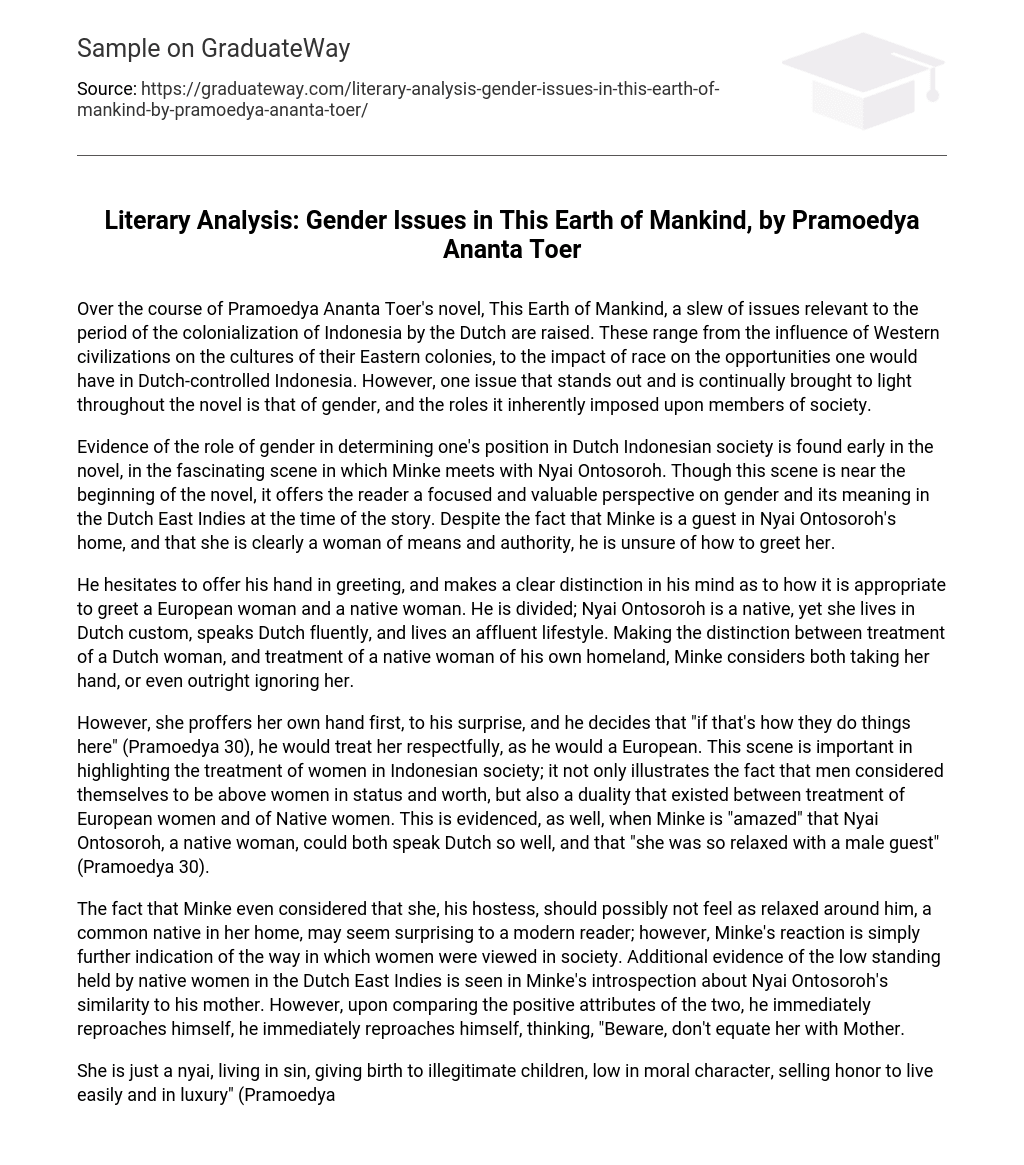In Pramoedya Ananta Toer’s novel, This Earth of Mankind, various issues pertinent to the Dutch colonialization of Indonesia are explored. These themes include the Western influence on Eastern colonies’ cultures and the effect of race on opportunities in Dutch-controlled Indonesia. Notably, the novel consistently addresses the issue of gender and the societal roles it enforced.
The novel provides early evidence of how gender determines one’s position in Dutch Indonesian society. In a captivating scene, Minke encounters Nyai Ontosoroh, offering insight into the significance of gender in the Dutch East Indies during that period. Despite Nyai Ontosoroh’s wealth and authority as the host, Minke is unsure how to greet her.
He is uncertain about offering his hand as a greeting, but he differentiates between how to greet a European woman and a native woman. He is conflicted because Nyai Ontosoroh, although native, lives in accordance with Dutch customs, speaks Dutch fluently, and leads a wealthy lifestyle. Minke considers both shaking her hand or completely disregarding her, reflecting on the differing treatment of Dutch women and native women in his own country.
The protagonist is surprised when the woman offers her hand first. He decides to treat her respectfully, as he would a European, acknowledging the cultural norms of the society. This scene is significant in showcasing the treatment of women in Indonesian society. It reveals not only the belief that men held themselves superior to women in status and worth, but also the contrasting treatment between European and Native women. The protagonist is amazed that Nyai Ontosoroh, a native woman, can speak Dutch fluently and is at ease with a male guest.
The fact that Minke even considered the possibility that his hostess, a common native in her home, might not feel relaxed around him may surprise a modern reader. However, this reaction from Minke further indicates how women were viewed in society. Additionally, Minke’s introspection about Nyai Ontosoroh’s similarity to his mother provides more evidence of the low status held by native women in the Dutch East Indies. Nevertheless, Minke quickly criticizes himself for comparing the positive qualities of the two, thinking, “Beware, don’t equate her with Mother.”
According to Pramoedya (32), Nyai Ontosoroh is seen as a sinful woman who lives in immorality, giving birth to illegitimate children and selling her honor for a life of ease and luxury. This reveals the narrator’s lack of respect for native women, particularly nyais, and their way of life. In Indonesia, a nyai was similar to a concubine in other societies, such as imperial China, where she would cohabit with a man and bear his children without being legally married to him. However, the narrator establishes that Nyai Ontosoroh holds a higher status than that and even struggles to refer to her as ‘Nyai’ when introduced to her.
According to Pramoedya, Minke admires Nyai Ontosoroh because she spoke Dutch fluently and politely, unlike other native mothers. He notes that she behaved like an educated European woman, which impressed him and made him overlook her gender. Additionally, Nyai Ontosoroh’s daughter, Annelies, also deviated from societal norms by being outgoing and straightforward, surprising Minke initially.
All the women he previously knew had to be submissive and show deference and obsequiousness towards men. However, Annelies, like her mother, is different. She sets herself apart from Minke’s idea of a European by fully accepting and even envying his status as a native. Annelies wishes she could be a native like her mother. As she shows Minke around the Ontosoroh property, she continues to amaze him. Not only is she intelligent and refined like her mother, but she also possesses authority over numerous workers despite being a young girl.
When Annelies brings Minke to a work area connected to the house, he is taken aback to find women engaged in business. He is particularly shocked by their clothing: “Even wearing calico shirts! Village women wearing coats! And not in their own kitchens!” (Pramoedya 35). His surprise at simply seeing women outside of the kitchen further highlights the deeply patriarchal nature of society in the Dutch East Indies. If it is considered highly uncommon to see a woman outside of her own home and kitchen, and dressed in a shirt, then it implies that male domination over women in that society was almost absolute.
The trial in chapter seventeen exemplifies the role imposed on women, especially native women. Nyai Ontosoroh argues that pure love should be recognized as equally powerful, if not more so than the relationship between concubine and master. She questions whether purchases are more genuine than pure love itself (Pramoedya 287). However, the judge dismisses her defense by pointing out that Annelies is an Indo and therefore superior to her, just as Minke was allowed to testify in court.
As a native woman, she spoke eloquently and sensibly, but her words were ignored. “This World of Mankind” is a powerful and evocative story that depicts life in the Dutch East Indies during the 19th century. It highlights gender and the role of women in society, addressing poignant and emotionally-charged issues. Pramoedya’s work offers valuable insight into a foreign world and teaches lessons on equality and gender that extend beyond its time.





